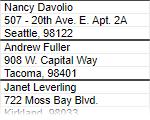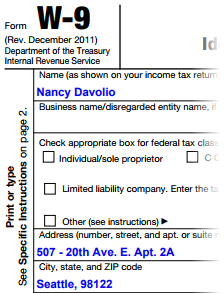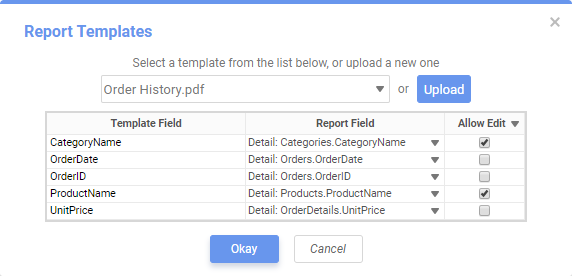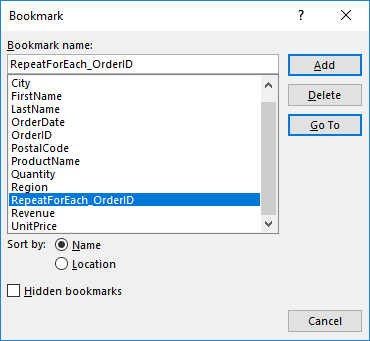Templates
You can use reports to dynamically fill out fields in templates and forms.
Template report with repeating data fills a set of form templates
To use a report to fill out a template:
Enter field data in cells on the report. For repeating data:
Repeating cells mapped to static template fields make a new instance of the template for each repeat.
Repeating cells mapped to limited-repeating template fields make a new instance of the template each time the number of values exceeds the limit.
Note: This is often undesirable. Ensure that there are appropriate constraints on your data and enough fields to fit it all.
Repeating cells mapped to unlimited-repeating template fields never make a new instance of the template. Overflowing data is cut off.
From the Report Options > Template window, select an existing template or click the Upload Template icon and add a new one.
For each template field:
Select a report cell containing text or data. Images, visualizations, and other widgets are not supported.
Leave it blank. Any bookmarked text shows as-is in the output.
Select whether or not to allow editing of that field in the exported PDF file using the Allow Edit checkbox.
Editing of fields in exported PDF templates
Click OK.
To remove a template from a report:
From the Template window, select the blank option from the template list.
Click OK.
Tip: Template reports must be exported in the same file type as the template. You may want to limit the export types to only that type using the Report Options > General Options window.
Making Templates
The process for making templates differs between the three supported types: PDF, Word, and Excel; as do the available features.
Caution: Close the template file before running or saving a report that uses it, or you may get an error.
PDF Templates
PDF templates support static fields and limited-repeating fields. PDFs are convenient for preexisting and standardized forms, such as for government or businesses.
To make a PDF template:
Open a PDF in a PDF editor program, such as Adobe Acrobat or PDFescape.
Add form fields where you will insert report data. For fields where text may span multiple lines, select the multi-line property.
Give each form field a unique name, as follows:
For static fields, which appear only once per template instance, use any name, with the exception of the format reserved for repeating fields.
For repeating fields, which are mapped to consecutive values in a repeating cell, use the following naming format:
Name.0, Name.1,...Where
Nameis shared by the repeating fields, and0maps to the first value,1maps to the next value, and so on.
Save the PDF. Then upload it to the report.
Microsoft Word Templates
Word templates support static fields, limited and unlimited-repeating fields, and conditional suppression.
Tip: Supported file types are .doc, .docx, and .rtf. Report templates exported as "RTF" will save to the original file type.
To make a Word template:
Open a document in Microsoft Word or a compatible document editor.
Add text where you want to insert report data.
Select the text—or in the case of repeating fields, a region of text—and insert a bookmark.
Bookmarks in Word display as grey brackets surrounding text
Give each bookmark a unique name, as follows:
For static fields, which appear only once per template instance, use any name, with the exception of the formats reserved for repeating and conditional fields.
For limited-repeating fields, which are mapped to consecutive values in a repeating cell, use the following naming format:
FieldName_0, FieldName_1, ...Where
Nameis shared by the repeating fields, and0maps to the first value,1maps to the next value, and so on.For unlimited-repeating fields, which are mapped to all the values in a repeating cell, use the following naming format:
RepeatForEach_FieldNameWhere
FieldNameis a unique name. A RepeatForEach section in templating follows similar structure and purpose to grouping within RTA Reporting. It is used to organize information under repeating groups within templates, arranging related information on the same page and separating groups with page breaks.
Important: Bookmark formatting for unlimited-repeating fields must follow specific spacing requirements. The opening bookmark bracket should be placed one line before the repeating field section begins, and the closing bookmark bracket should be placed one line after the repeating field sections ends. Please refer to the Employee Information example above for a visual reference. If this formatting is not followed, an "itemStart and itemEnd must be contained in one text body" error may be thrown.
Optional: To conditionally show or hide text:
Select the text and add a bookmark with the following naming format:
KeepIF_FieldNameWhere
FieldNameis a unique name.In the report, map this field to a cell with a formula that returns 1 if the text should be shown, and 0 if the text should be hidden.
Example:
=If({Products.ProductName} = "Chai", 1, 0)
Save and close the file. Then upload it to the report.
Microsoft Excel Templates
Excel templates work differently than other types. Templates are used to fill Excel columns with report data. This is useful for passing data to Excel charts, pivot tables, and macros.
To make an Excel template:
Open an Excel file in Microsoft Excel or a compatible spreadsheet editor.
The first worksheet is used for dynamic report data. Repeating cells are mapped to columns in the worksheet. For each column where you will add report data, enter a unique name to the topmost cell in the column. All following cells must be empty.
Formatting an Excel file to be used as a template
Save the file. Then upload it to the report.









